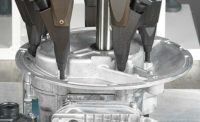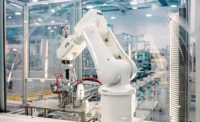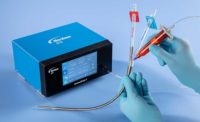What’s New With Rotary Indexers
Servo indexing and flexibility drive numerous assembly applications.






One of the simplest devices for partially automating an assembly process is a rotary indexing table. This device consists of a circular steel plate and a drive for turning it. Parts rest in nests spaced equally along the table’s circumference.
Self-contained machines and tooling for specific tasks are arrayed around the perimeter. As the table rotates, it stops intermittently to “dwell” for a fixed period of time, so that an assembly operation can be performed at each station.
A wide variety of assembly, test and inspection applications rely on rotary indexers.
“Almost any part that has multiple pieces to assemble for a finished product can be adapted to a rotary table,” claims Barry Eilert, sales manager for automation products at Sankyo Automation. “As always, [engineers] are looking for products that will produce faster ways to boost production at a cost that is the same or less expensive.”
Automotive applications for rotary indexers include body-in-white components that are being welded, such as frames, doors and hoods. Many types of auto parts are also assembled with the equipment, including hinges, latches, motors, sensors and switches.
In addition, medical devices ranging from blood glucose test strips to syringes are mass-produced with high-speed equipment that use rotary indexers. In addition, the devices are commonly used to assemble consumer goods such as pens, razors, soap dispenser pumps and toothbrushes.
“The major change continues to be the additional offering of more and more servo-indexing options,” says Bill Eppich, vice president of WEISS North America Inc. “In the past, mechanical cam indexing was the standard. Today, every manufacturer of indexing technologies has added more servo-controlled product to their offering.”
“The most challenging applications are the ones that require extremely high-speed indexes that index and stop for a period of time as a process is performed, such as 0.30 seconds for 90 degrees,” adds Benedict Talan, president of Motion Index Drives Inc. “With high-speed applications, it is important to have quick response times from variable frequency drives (VFDs) or servo drives.
“When using a fixed cam indexer in extreme high-speed indexes, we will manufacture the cam with a longer mechanical dwell period to allow the electronics ample time to stop the motor within the mechanical dwell period,” explains Talan. “During these fast index times, even with longer mechanical dwell periods, the electronics may only have 90 milliseconds to react and stop the motor.
“We also stress the importance of having a fast-reacting VFD and braking resistors to be able to dissipate the energy going back to the VFD during these high-speed index applications,” notes Talan. “In programmable cam indexing, these fast index times become more challenging and take a lot of time after delivery to make sure the units are commissioned correctly to avoid any premature failures.
“It is very important that the correct movement profiles are utilized based on what we have suggested, as well as proper tuning of the servo motors and drives based on each individual manufacture of the particular motors that will be used,” warns Talan. “Too aggressive of acceleration programmed into the servomotors is the leading cause of mechanical failures.
“The amount of torque transmitted to the internal components during acceleration grows exponentially and can easily be more than 10 times of the recommended torque allowed,” Talan points out. “Servomotors and robot motors have a tremendous amount of startup torque; if machine builders are not careful with following the recommended movement profile, it will cause major problems.
“We make an effort to review all programmable applications once they have gone through the initial commissioning process to ensure the correct movement profiles are used,” claims Talan.
According to Talan, there are many ways assembly line productivity can be improved with rotary indexers. “Increasing quality of parts can be achieved with utilizing a rotary cam indexers which have extremely high accuracies and repeatability from station to station,” he explains. “Rotary cam indexers have the ability of fast stopping times during light screen violations or emergency stops to allow an operator to be closer to the machines for loading and unloading processes.
“Having a closer light screen will improve productivity, [because machine operators] will not have to take as many steps during the day or in some cases can be seated right next to the machine reducing fatigue,” says Talan.
“Most rotary cam indexers are also maintenance-free,” adds Talan. “When sized correctly and commissioned correctly, rotary cam indexers will last 20 or more years without any issues, so downtime [is] minimal.”
Numerous Options
Manufacturing engineers can choose between three basic drives for rotary indexing applications: traditional mechanical cam index tables, servo mechanical (constant lead cam) index tables and direct-drive servo index tables.
“The technology used to manufacture index drives has also evolved,” notes Talan. “Modern CNC-controlled machining equipment allows for revolutionary index drives that offer superior accuracies. Now, the accuracy possibilities are up to 25 percent better than they were years ago.
“Rotary indexers have also evolved to be much stronger due to larger internal components utilizing the same outer dimensions and footprint,” explains Talan. “This allows for a much more cost-effective index drive to handle an application that in the past was at least one frame larger.”
According to Talen, many manufacturers are looking for the most cost-effective solution for their application, while also looking for the highest speed possible to index a load for the least cost. “In addition to these features, customers expect a maintenance free long-life solution to last the full duration of a program without any maintenance requirements,” he points out.
“High-speed manufacturing is a driving factor, with machines being fully automated and manufacturers looking to eliminate the transfer time an index drive consumes in the process,” says Talan. “While looking at this, they also want to minimize the cost, so a delicate balance of index time vs. cost of the unit is considered when they size an index drive.”“One thing we have seen recently are fixed stop units driven with a servomotor, which allows the machine builder and end user to get a slightly faster cycle time,” adds Eilert. “We also see rotary tables used to drive chain conveyors for quicker, accurate movement of parts down the line.”
Manufacturers in all industries also continue to demand flexibility and speed.
“Speed and accuracy are still important, but flexibility is driving demand,” notes Eppich. “People want to run more applications or similar part types on the same machine. Because of more demand for high-mix products today, we don’t see as much low-mix, high-volume continuous motion applications as we did in the past.”
In addition to servo-controlled offerings, Eppich says the ring index table market has grown considerably. “WEISS was the original supplier of cam-based ring indexers back in 2001,” he explains. “We now see many ring indexing drives available on the market today.
“This technology allows for significant design advantages when building an indexing platform,” claims Eppich. “The large, open center allows for mounting processing equipment on the inside of the machine, running utilities and structures through the center, as well as higher accuracies and support at the part [fixtures].
“Direct-drive indexing products offer more speed, accuracy and flexibility vs. cam-based products,” says Eppich. That’s one reason why they’re popular with automotive and medical device manufacturers, especially for applications that involve test kits and sensors.
“We have seen an enormous need for our products due to COVID-19,” explains Eppich. “Mask production and test kit production have been the main drivers of [those] applications.
“We’re also currently working with several companies that are in the process of developing autonomous and electric vehicles,” adds Eppich. “They have numerous types of sensors that need to be tested and validated. We’re building some multiaxis positioning systems that manufacturers can actually put their vehicles on to get feedback while they calibrate various types of sensors and software.”
“One of the latest trends in rotary indexers are fast indexing times combined with higher precision to create a higher output in the automation process and get more productivity,” says Dustin Stewart, project engineer at Fibro Inc. “Energy consumption on the drive, motor efficiency is a bigger [issue today] topic lately.
“[More engineers are also looking for] geared motors instead of individual gearboxes and separate motors,” notes Stewart. “[They also want] low cost, fast delivery and fast cycle times.”
New Products
Engineers can choose a variety of innovative products that make it easier than ever to use rotary indexing technology on assembly lines.
For instance, WEISS recently unveiled its Flex Dial Chassis. “The fully operational rotary indexing chassis is based on a servo-controlled index ring and servo-controlled pick-and-place robots,” explains Eppich. “A completely flexible rotary chassis allows a machine builder to commission a project much faster and with less risk.
“[Our] Flex-Dial Chassis systems provide the opportunity to enhance manufacturing processes through the use of standard automation platforms,” adds Eppich. “It features our fully programmable NR Series index tables, aluminum dial plate, steel base plate, and a modular and expandable control system with various fieldbus interfaces.
“The total cost of construction, installation and commissioning are greatly reduced thanks to our innovative plug-and-play [technology],” claims Eppich. “Prior to delivery, each system goes through a comprehensive functionality and quality inspection, after which the system can be set up and put into operation on-site quickly and smoothly.”
Sankyo Automation’s newest product is the RU Series, a zero-backlash rotary table that is servo driven. A constant lead cam and servomotor drive enable programmable motion. The preloaded cam and turret eliminate backlash.
“The servo allows for any indexing pattern and for that pattern to be changed at any time,” says Eilert. “Special output bearings allow for heavier load capability. It is designed to move heavy, large loads faster and with more precision.”
The RU Series servo indexing table is available in 11 sizes. The tables come with varying ratios to maximize the motor’s torque capacity, speed requirements and accuracy.
Sankyo Japan also recently released a mini version of a servo rotary table, the Mi Series, that will soon be available in North America.
Motion Index Drives’ newest product is the TMF350.
“This revolutionary [product] is the smallest, most compact freely programmable index drive ever created,” claims Talan. “[It] has the torque and inertial load capacity of an index drive twice its size. It can fit nearly any small compact machine to provide high index speeds, and can be driven by a servo or stepper motor.
"We will be extending our line of TMF series fully programmable indexers to the smaller range and these units will replace the smaller RT programmable series we currently have in our lineup," says Talan. "The smaller TMF series mechanically has an advantage over the current RT series programmable indexers by having more cam followers engaged in the cam at one time to move the mass attached to the output dial of the rotary cam indexer."
Fibro’s newest rotary indexing product is the Fibrotor VM.NC and VR.NC. They feature faster, smoother indexing with large thru holes. “These table designs are perfect for many different automation applications,” claims Stewart. “[They are] fast, precise and very robust, combined with low maintenance needs.”
Looking for a reprint of this article?
From high-res PDFs to custom plaques, order your copy today!









